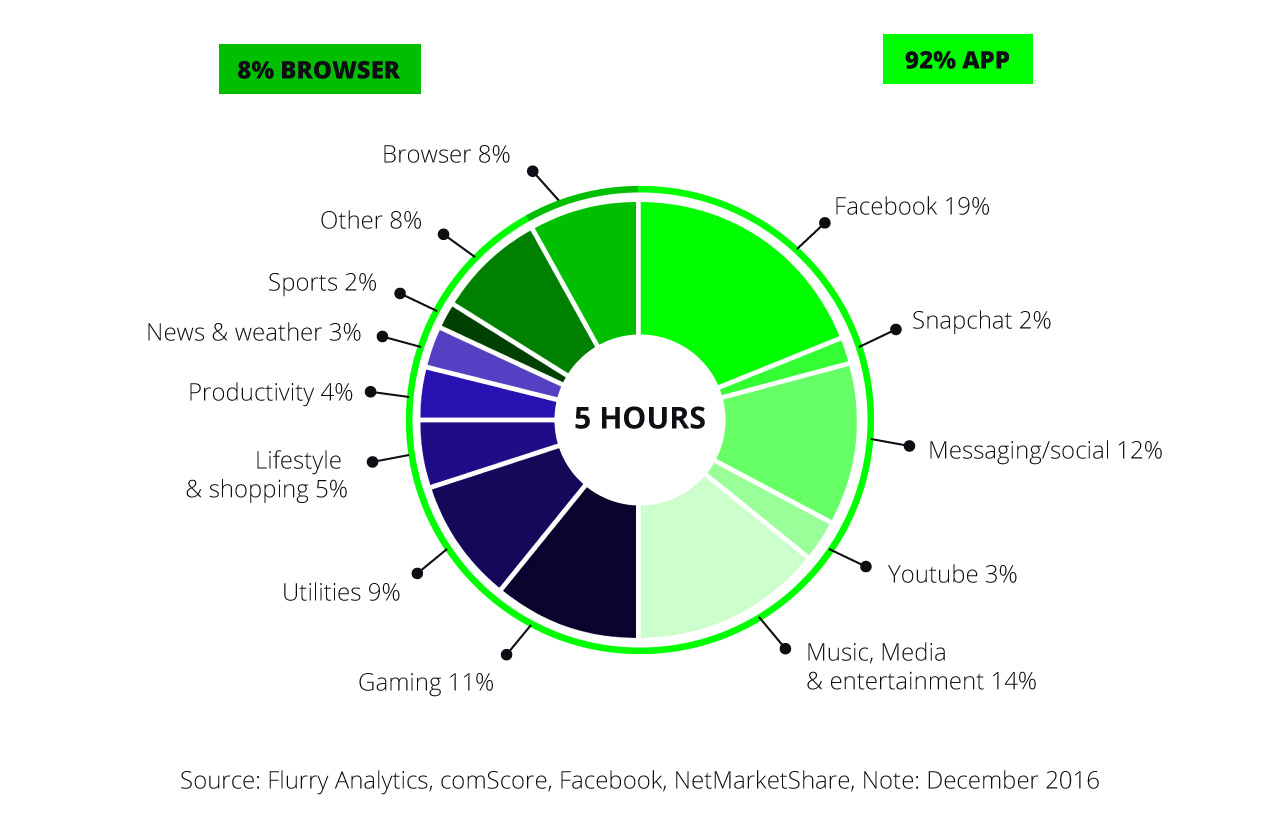Mobile Web VS Mobile Apps, Reach VS Engagement: How Do You Pick One?
Have you ever thought how many hours Americans spend on average using their mobile devices? As reported by the last researches, carried out by eMarketer, Flurry and Business.com, they spend 5 hours a day using their mobile devices, time spent on mobile increased while number of users declined. The amount of time people spend using mobile web or mobile apps has been increasing steadily over time, even if during last years a change in trends has been underlined. Moreover, people seem prefer mobile apps rather than mobile web.
According to the above-mentioned research, during 2017, so far, apps account for more than 90 % of people’s non-voice smartphone time while mobile web accounts just for less than 10 %. Total time spent on apps increased of 20% compared to 2015 data, while time spent on mobile web slightly decreased, and predictions make clear this trends will last for the next year as well. At this point is important to understand, the reasons behind this trend. According to Monica Peart – eMarketer forecasting director – “ Mobile apps are easily accessible and can be launched faster than mobile web. Apps also provide an immersive experience with a greater degree of functionality, integrating with the device’s other apps and capabilities as GPS, camera or contact list. These elements keep users more engaged in each session, something that a mobile website cannot rival ”. But there’s another element determining the transition from mobile web to mobile apps: Chatbots. The dynamics of the relationship between companies and clients has changed during last year; clients prefer to do research by their own before purchasing, as well as to solve problems related to a product or service by their own rather than contacting a company’s sales team or customer care. In order to address these changes, companies are adopting innovative technologies based on virtual and artificial reality to let clients interact as they prefer. In this context the concept of ChatBot, an interface simulating a conversation between a robot and a human being, sticks out as one of the most promising tool allowing to address consumers’ need in a more direct way. Chatbots, integrated in the most downloaded messaging apps, are now considered as an essential element in driving a more engaging customer experience, making the client service more efficient and easier, adding another step in the transition to mobile apps.
As depicted in the pie chart below, more than half the time spent on apps is in social, messaging or entertainment applications, following the inception of a brand new concept: Communitainment. It indicates the communication realized for the sole purpose of entertainment.
Facebook has the highest share of time spending, 19%, which is supposed to grow even more thanks to the launch of Facebook and Instagram stories, followed by other music or entertainment apps and by Snapchat and Youtube, the ultimate communitainment apps. During 2017, Americans are expected to spend 5 minutes a day using messaging apps, which represents an increase of more than 140% compared to the average time spent using the same apps in 2016.
Although this increasing time spent on mobile, researches show, on the other hand, a decrease in the overall app usage, meaning a decrease in the average number of apps used by a single person. According to Cathy Boyle – eMarketer principal analyst- “American consumers spend the bulk of their app time conducting five activities: listening to digital audio, social networking, gaming, video viewing and messaging”. In 2016, American smartphone users utilized an average of 21 apps per month; by the end of 2019 this amount is predicted to drop to 20 apps.
When dealing with the choice between mobile apps or mobile web is important to understand that they can be considered as two tools serving different needs. People’s app usage is driven by routines: they usually tend to use the same five apps, so aside these, creating loyal app users is not easy at all. This means that, before creating loyalty, people need to be reached and attracted, which is what mobile web is fit to do. Nielsen and Forrester Research emphasize how mobile web is the perfect tool for reaching audience, while mobile apps for driving engagement and turning users into loyal clients. So as for mobile, the central matter is not the choice between mobile apps or mobile web, but the choice of the approach fitting better the brand needs in each stage of their strategic planning.



